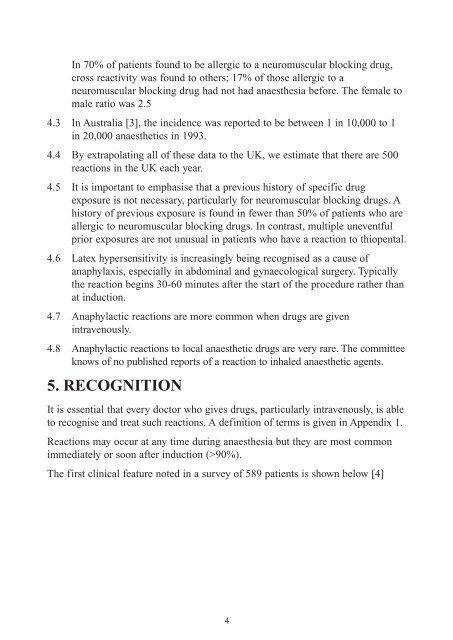suspected anaphylactic reactions associated with anaesthesia - aagbi
suspected anaphylactic reactions associated with anaesthesia - aagbi
suspected anaphylactic reactions associated with anaesthesia - aagbi
You also want an ePaper? Increase the reach of your titles
YUMPU automatically turns print PDFs into web optimized ePapers that Google loves.
In 70% of patients found to be allergic to a neuromuscular blocking drug,cross reactivity was found to others; 17% of those allergic to aneuromuscular blocking drug had not had <strong>anaesthesia</strong> before. The female tomale ratio was 2.54.3 In Australia [3], the incidence was reported to be between 1 in 10,000 to 1in 20,000 anaesthetics in 1993.4.4 By extrapolating all of these data to the UK, we estimate that there are 500<strong>reactions</strong> in the UK each year.4.5 It is important to emphasise that a previous history of specific drugexposure is not necessary, particularly for neuromuscular blocking drugs. Ahistory of previous exposure is found in fewer than 50% of patients who areallergic to neuromuscular blocking drugs. In contrast, multiple uneventfulprior exposures are not unusual in patients who have a reaction to thiopental.4.6 Latex hypersensitivity is increasingly being recognised as a cause ofanaphylaxis, especially in abdominal and gynaecological surgery. Typicallythe reaction begins 30-60 minutes after the start of the procedure rather thanat induction.4.7 Anaphylactic <strong>reactions</strong> are more common when drugs are givenintravenously.4.8 Anaphylactic <strong>reactions</strong> to local anaesthetic drugs are very rare. The committeeknows of no published reports of a reaction to inhaled anaesthetic agents.5. RECOGNITIONIt is essential that every doctor who gives drugs, particularly intravenously, is ableto recognise and treat such <strong>reactions</strong>. A definition of terms is given in Appendix 1.Reactions may occur at any time during <strong>anaesthesia</strong> but they are most commonimmediately or soon after induction (>90%).The first clinical feature noted in a survey of 589 patients is shown below [4]4

















